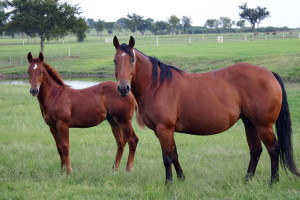Written by Tina M. Anderson, PhD
Equine Specialist
Purina Animal Nutrition
Original Publish Date January 2014
 Broodmares have specific nutritional requirements that differ from other classes of horses. There are differences both in the amount of feed mares need and the nutrient concentration needed in that feed. Throughout the year the broodmare goes through three different phases, each with a different nutritional demand. She is either in early gestation, late gestation or lactation. To keep this cycle going consistently requires that the mare receive the proper health care and nutrition. Given the time of year, let’s focus on that early and late gestating mare.
Broodmares have specific nutritional requirements that differ from other classes of horses. There are differences both in the amount of feed mares need and the nutrient concentration needed in that feed. Throughout the year the broodmare goes through three different phases, each with a different nutritional demand. She is either in early gestation, late gestation or lactation. To keep this cycle going consistently requires that the mare receive the proper health care and nutrition. Given the time of year, let’s focus on that early and late gestating mare.
Body Condition Affects Reproductive Performance
Research has demonstrated that the reproductive performance of non-lactating mares is best when they are maintained at a condition score of 5 or higher. Establishing and maintaining pregnancy becomes increasingly more difficult when the body condition score of mares drops below this level. It is difficult for a mare to gain weight during lactation. She simply cannot eat enough. Most mares will experience a small to moderate weight loss during lactation. To ensure mares are at a condition score of 5 or more at the time of rebreeding, they should foal at a condition score of more than 6. This degree of body fatness should be established during the first eight months of pregnancy, since digestive capacity is considerably reduced during the last trimester. Research has also shown that obesity (condition score 9) is not detrimental to reproductive performance and does not increase foaling difficulty. This degree of body fatness, however, severely limits a horse’s performance capability and is considered unhealthy.
Body condition may be the single largest factor affecting the reproductive performance of mares. Mares maintained in moderate to fleshy condition cycle earlier in the year, require fewer cycles per conception, have a higher pregnancy rate and are more likely to maintain pregnancies than are thin mares. Because of the subjective nature of terminology such as “fleshy”, “good condition”, etc., researchers developed a numeric scoring system to objectively identify the body condition of a mare. Using this system, research has determined that a condition score of less than 5 in lactating mares indicates that they may not have enough stored body fat to support efficient reproductive performance. Those mares are more likely to skip a breeding season than are mares with a condition score of 6 or more. This is especially prevalent in mares that are 15 years of age or greater. Reproductive performance often can be improved in thin mares when they are fed to gain weight. However, putting weight on a thin mare, particularly during lactation can be costly and dangerous due to the high levels of feed intake required to achieve gain. While no foaling difficulties have been shown in mares in obese condition, there are no reproductive advantages to keeping mares in condition scores of 8 or 9. Therefore, scores of 5.5 to 7.5 represent the optimum. Management of body condition should be supported by careful selection of feedstuffs and accurate ration formulation, because this is an important step in promoting normal foal growth (see Body Condition Scoring Chart).
Total Feed Intake
Total daily feed intake by mares (hay plus concentrate) normally ranges from 1.5 percent to 3.0 percent of body weight, with 2 percent serving as an average. Actual daily feed intake depends on the type and quality of hay or grazing and on the crude fiber level and energy density of the concentrate. As the fiber level increases and energy density decreases, the amount of feed required to meet energy demands will increase. However, as forage quality decreases, voluntary intake often decreases as well. This can present a problem in providing enough energy to maintain the desired body condition. This is common this time of year as pastures freeze and become less available. Furthermore, daily feed intake can vary between individuals. Feed intake may have to be increased for hard keepers or heavy milkers, and decreased for other mares who are easier keepers. It is also good to keep in mind that pregnant mares may seem “heavy”, but when handling their ribs it may appear they lack proper body condition.
Early and Mid-gestation
A non-lactating, pregnant mare in the first 8 months of gestation has nutrient requirements very similar to those of any mature, idle horse. The developing foal gains only 0.2 pounds/day during this time and does not present a significant nutritional demand on the mare. It is usually considered sufficient simply to meet the mare’s nutrient requirements for maintenance. This may be accomplished with free choice grazing of quality pasture. In this situation, mares may consume as much as 3 percent of their body weight, which can meet their needs for protein and energy during this stage. However, mineral requirements may not be met, particularly in mineral deficient pastures. Therefore, supplemental minerals will be necessary. This may be accomplished with a free-choice loose mineral or a mineral block for horses. A trace mineralized salt block will not provide sufficient mineral to meet requirements, therefore it is recommended that a free-choice mineral and a salt block be provided at this time. High quality hays can also be excellent for maintaining dry, pregnant mares in the early stages of pregnancy. As an average, mares will require around 2 percent of their body weight in high quality hay if no supplemental grain is used. Grazing and/or hay will usually maintain a mare that is already in acceptable body condition, but often will not put sufficient weight on mares that are in marginal condition. When pasture or hay quality declines, or is not available in adequate amounts, mares will need supplemental concentrate to maintain body weight and condition. A quality concentrate fed at .5 to .75 percent of body weight will help keep mares in good shape.
Late Pregnancy
As a mare enters the last 3 to 4 months of pregnancy, nutrient requirements increase, as the unborn foal is growing more rapidly; averaging 1 pound/day. During this time the intake of protein, energy, vitamins and minerals needs to be increased. Even in situations where forage is sufficiently maintaining mares in acceptable condition, it is important that they receive quality concentrate supplementation. While forage may be able to provide sufficient calories to maintain the body condition of the mare, other nutrients, particularly protein and minerals, will be inadequate. Research has shown that foal birth weight can be adversely affected when mares do not receive adequate protein during late gestation, even when the mares maintain a condition score of 5.5 to 7.5. Therefore, simply having mares in good condition during late gestation does not guarantee proper foal development. It is during the tenth month that the greatest amount of mineral retention occurs in the unborn foal. In addition to this, mares’ milk is practically devoid of trace minerals, such as copper, that are essential for proper bone development. Therefore, adequate mineral nutrition of the mare is critical for normal fetal development and to provide sufficient minerals for the foal to be born with stores of these nutrients to draw upon after birth. A supplemental feeding program that provides a good protein, vitamin and mineral balance is necessary to properly support the growth and development of the foal. Diets containing added fats or oils can be used to help mares in unsatisfactory condition gain the desired weight. The advantage of feeding these diets is that body condition can be improved without having to feed excessive amounts of concentrate, since the higher fat diets tend to have a higher digestible energy level.
If there is a take home message to this topic, it is that it is too late to help the development of the foal through nutrition once it hits the ground. Proper foal development starts in utero. A supplemental feeding program that provides a good protein, vitamin and mineral balance is necessary to properly support the growth and development of the foal, particularly in late gestation.





